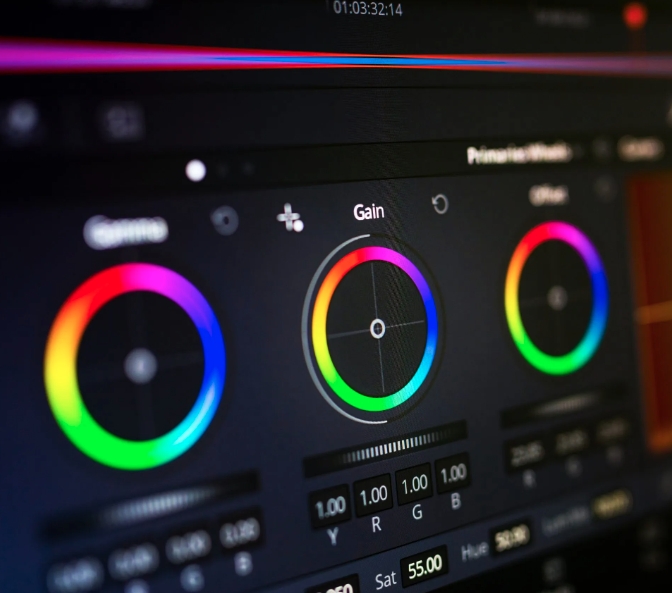A színek varázsa:
Merülj el a filmes color grading világában!
A filmvásznon látott képek sosem véletlenszerűek. A fények, árnyékok és mindenekelőtt a színek gondosan megtervezett összjátéka teremti meg a filmek hangulatát, és segít elmesélni a történetet. Ebben a folyamatban kulcsszerepet játszik a color grading, a filmek utómunkájának egyik legfontosabb eleme. De mit is takar pontosan ez a kifejezés, és hogyan fejlődött az idők során? Cikkünkben erre keressük a választ.
Mi is az a color grading?
A color grading a film utómunkafolyamatának része, amely során a film képi világának színeit, tónusait és kontrasztját finomhangolják. Nem csupán a hibák javításáról van szó, hanem egy kreatív folyamatról, amellyel a film hangulatát, érzelmi hatását és stílusát határozzák meg. A color grading segítségével:
- Hangulatot teremthetünk: A hideg színek (kék, zöld) melankóliát, távolságot sugallhatnak, míg a meleg színek (vörös, narancs) intimitást, szenvedélyt fejezhetnek ki.
- A történetet hangsúlyozhatjuk: A színekkel irányíthatjuk a néző figyelmét a fontos részletekre, vagy akár szimbolikus jelentést is adhatunk egyes jeleneteknek.
- Stílust definiálhatunk: A color grading segítségével egységes vizuális stílust hozhatunk létre az egész film számára, ami hozzájárul a film egyedi identitásához.
A color grading története
A színes film megjelenésével a 20. század elején a filmesek először csak a nyersanyag tulajdonságaira hagyatkozhattak. Az igazi változást a telecine megjelenése hozta az 1950-es években. Ez a technológia lehetővé tette a film digitalizálását és a színek elektronikus korrekcióját. Ekkor született meg a color timing fogalma, amely a color grading előfutárának tekinthető.
A digitális technológia térhódításával a 21. században a color grading egyre kifinomultabbá és kreatívabbá vált. A szoftverek fejlődésével a filmeseknek sokkal nagyobb szabadságuk nyílt a színek manipulálásában, ami új távlatokat nyitott a filmkészítésben.
A color grading fogásai
A color grading során számos technikai és kreatív eszközt alkalmaznak. Néhány gyakori fogás:
- Elsődleges korrekció (Primary Correction): Az alapszínek (vörös, zöld, kék), a kontraszt, a fényerő és a telítettség beállítása.
- Másodlagos korrekció (Secondary Correction): Egy adott szín vagy színtartomány finomhangolása. Például egy adott bőrszín korrekciója vagy egy égbolt kékjének intenzitásának növelése.
- Görbék (Curves): A tónusok és kontrasztok pontos beállítására szolgáló eszköz.
- LUT-ok (Lookup Tables): Előre definiált színbeállítások, amelyek gyorsan alkalmazhatók a felvételekre.
- Maszkolás és követés (Masking and Tracking): Különböző területek elkülönítése és azok színeinek egyedi beállítása.
Használt programok
Számos professzionális szoftver áll a color graderek rendelkezésére:
- DaVinci Resolve: Az iparági standard, komplex és rendkívül sokoldalú szoftver.
- Adobe Premiere Pro és After Effects: Az Adobe kreatív csomagjának tagjai, amelyek szintén kínálnak színkorrekciós és grading eszközöket.
- Final Cut Pro: Az Apple professzionális videószerkesztő szoftvere, amely szintén tartalmaz színkorrekciós funkciókat.
The magic of colour: immerse yourself in the world of cinematic colour grading!
It's the carefully designed interplay of lights, shadows and, above all, colour that creates the mood of a film and helps tell the story. Colour grading, a key element of post-production, plays a key role in this process. But what exactly is this term and how has it evolved over time?
What is colour grading?
Colour grading is part of the post-production process of fine-tuning the colours, tones and contrast of a film's visual world. It's not just a matter of correcting mistakes, but a creative process to set the mood, emotional impact and style of the film. We can use colour grading to:
- Create a mood: cold colours (blue, green) can suggest melancholy and distance, while warm colours (red, orange) can express intimacy and passion.
- Emphasise the story: we can use colour to draw the viewer's attention to important details or even to give symbolic meaning to certain scenes.
- Define a style: colour grading can be used to create a coherent visual style for the whole film, contributing to its unique identity.
The history of colour grading
With the advent of colour film at the beginning of the 20th century, filmmakers could initially rely only on the properties of the raw material. The real change came with the advent of telecine in the 1950s. This technology allowed film to be digitised and colour corrected electronically. The concept of colour timing, which can be seen as the forerunner of colour grading, was born.
With the rise of digital technology in the 21st century, colour grading has become increasingly sophisticated and creative. The development of software has given filmmakers much greater freedom to manipulate colour, opening up new horizons in filmmaking.
The tricks of colour grading
Colour grading uses a variety of technical and creative tools. Some common techniques include:
Primary Correction: Adjusting primary colours (red, green, blue), contrast, brightness and saturation.
Secondary Correction: Fine-tune a specific colour or colour range. For example, correcting a specific skin tone or increasing the intensity of the blue of a sky.
Curves: A tool to precisely adjust tones and contrasts.
LUTs (Lookup Tables): Pre-defined colour adjustments that can be quickly applied to shots.
Masking and Tracking: Separate different areas and adjust their colours individually.
Programmes used
There is a wide range of professional software available for colour graders:
- DaVinci Resolve: the industry standard, complex and highly versatile software.
- Adobe Premiere Pro and Adobe After Effects. Members of the Adobe Creative Suite, which also offers colour correction and grading tools.
- Final Cut Pro: Apple's professional video editing software, which also includes colour correction features.
Reference still to download and follow along:
https://cgcpublic.s3.us-west-2.amazon...
https://cgcpublic.s3.us-west-2.amazon...
Footage to download and follow along:
Egy érthető segédanyag magyarul:





Leave a Reply